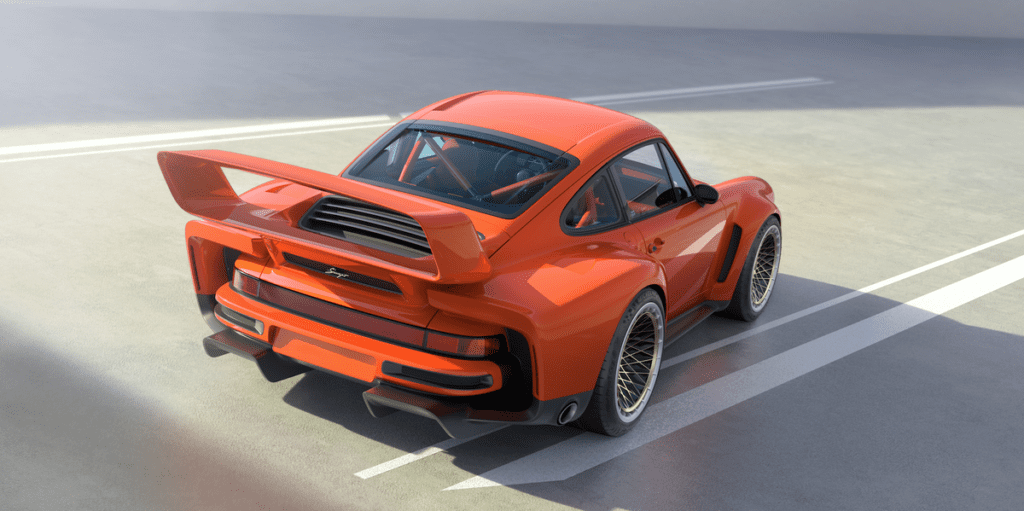Singer DLS Turbo Is a Porsche 934/5 Reimagined for Modern Times

The Singer DLS Turbo is a modern-day reinterpretation of the Porsche 934/5 endurance racers from the 1970s.Based on 964-generation 911s, Singer’s latest custom-built cars boast a carbon-fiber widebody, a 700-hp twin-turbo 3.8-liter flat-six, and a manual gearbox. Singer offers the DLS Turbo with track- or road-oriented hardware, with the former featuring an enormous rear wing.
Nearly every iteration of the Porsche 911 now comes with a turbocharger—in fact, you have to pay more for the ones that don’t—but the ones that wear the “Turbo” script out back remain very special. Porsche wasn’t the first company to adapt turbocharging for race and road, but it was perhaps the most successful. In 1977, the owner of a Porsche 930 could have driven their whale-tailed grand tourer to all eight races of the SCCA Trans American series and seen the racing version of the road car win a convincing six times. Singer, the vaunted Porsche restoration house, has now revealed a new creation that combines both into the essence of a 911 Turbo.
A 934/5 Reborn
As ever, Singer is very careful to point out that it is not a boutique manufacturer like RUF or Alpina, but it merely seeks to reimagine what the ideal of a Porsche 911 could be. Founded in 2009, the company now has multiple rivals but also possibly no real competition. In the classic 911 world where cost is no object, a Singerized Porsche is the standard which others attempt to achieve.
Two new cars seek to raise an already high bar somewhere into the upper ionosphere. Built as tribute to the Porsche 934/5 racing machines that dominated in endurance racing, the “Dynamic and Lightweighting Study (DLS) – Turbo,” are a matched pair of rocketships, one built for the track, the other for the road.
Dynamics and Lightweight Study sounds like a chapter out of an aeronautical engineering textbook, but the actual experience is more Top Gun: Maverick. The original DLS was created in 2008, infused with exotic composite materials and built around a naturally aspirated 4.0-liter flat-six built by Williams Advanced Engineering. That engine made 500 horsepower at 9300 rpm and was filled with excruciatingly painful details like each individual valve costing $30,000. The whole DLS cost $1.8 million, yet the limited number were almost immediately all spoken for.
Singer also reimagined the 911 Turbo last year, slightly softened up versus the company’s previous projects. With a torque-rich and flexible turbocharged 3.8-liter flat-six good for 450 horsepower, both a coupe and later a 510-hp cabriolet variant were intended to be grand tourers in the same mold as the original 911 Turbo. A six-speed manual provided two more forward gears than customers got in the 1970s.
Track or Road?
The new DLS Turbo, which has a name like a gaming mouse, combines the hardcore engineering of the F1-style 911 rebuilt with the tremendous power available via forced induction. Both the Blood Orange track-focused car and the Moet Black road-oriented machine have a new twin-turbo 3.8-liter flat-six with electric wastegates and air-to-water intercooling. It makes an estimated 700 horsepower and revs to over 9000 rpm.
If being around the earliest Singer restorations was all about noticing the subtle details, the two DLS Turbo models are as wild as it comes. Huge rear fenders balloon out like in a modern interpretation of the 1970s racers of IMSA and Le Mans. The road-going car has a duckbill spoiler rather than the box-wing of the track-focused machine, but both look completely insane.
The closest comparison is the Kremer K3 Strasse commissioned by F1 team owner Walter Wolf in 1980. However, where that near-800 horsepower bit of lunacy ate a set of rear tires every hundred miles and only had air-conditioning for the driver, Singer’s DLS Turbo builds will doubtless be as flawlessly executed as each one of its former creations.
It is therefore to be hoped that, despite the eye-watering, multi-million dollar cost of each one of these cars, they actually get driven. After all, while the 911 Turbo is now a highly collectible car, especially the racing version, Porsche differentiated itself from the Italian exotics by building cars that were intended to endure. One of the highest-mileage 911s in existence, a 1976 Canadian-market 930 owned by original-owner Bill MacEachern of Toronto, Ontario, now has more than 800,000 miles on its odometer.
As a cross-pollination between endurance racer and road-car, these are the wildest Singer-restored Porsche 911s yet. The bar is raised, the standard reset.
This content is imported from poll. You may be able to find the same content in another format, or you may be able to find more information, at their web site.
Contributing Editor
Brendan McAleer is a freelance writer and photographer based in North Vancouver, B.C., Canada. He grew up splitting his knuckles on British automobiles, came of age in the golden era of Japanese sport-compact performance, and began writing about cars and people in 2008. His particular interest is the intersection between humanity and machinery, whether it is the racing career of Walter Cronkite or Japanese animator Hayao Miyazaki’s half-century obsession with the Citroën 2CV. He has taught both of his young daughters how to shift a manual transmission and is grateful for the excuse they provide to be perpetually buying Hot Wheels.



